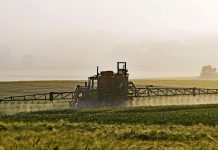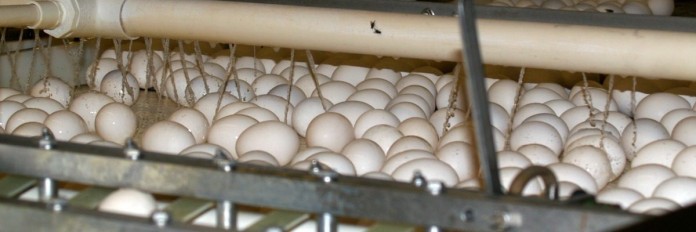SALEM, Ohio — Farmers and poultry representatives criticized the U.S. Department of Agriculture for its early handling of the current outbreak of highly pathogenic avian influenza, during a July 7 hearing before the U.S. Senate Ag Committee.
But they also commended the agency, and the Animal Plant Health Inspection Service — for working out many of the kinks in recent weeks.
‘“We believe that a lack of clear communication created the confusion we specifically saw in Iowa and Minnesota,” said Brad Moline, a turkey producer and National Turkey Federation representative. “We firmly believe unclear communication contributed to the spread of this disease.”
Moline said the main issue was delays in depopulating affected flocks, because farmers didn’t know how it should be carried out. He said some farms saw 11 days go by before birds were depopulated, something he said should have happened much sooner — even within a day.
Moline said he was also concerned about some of the initial staff the USDA contracted with, who did not convey a clear, consistent message to farmers.
He said some of the staff also breached biosecurity practices — the very thing farmers were being told to control — in order to control the spread of the disease.
“Let’s be completely clear here: APHIS officials need to examine their own biosecurity practices,” he said.
John Clifford, the APHIS deputy administrator for veterinary services, said there were definitely some communication issues as the disease broke, and some issues with USDA contractors.
Making improvements
He said the agency has worked to overcome many of those early struggles, but he also noted that carrying out a depopulation is not easy. The first thing, he said, is to assess the number of birds and create a flock plan, including a plan for indemnities and how the birds will be euthanized and disposed of.
He said staff can usually euthanize a little more than 100,000 birds a day with CO2, which means flocks of several hundred thousand could take several days. Another issue is handling all the waste — which not only includes the dead birds, but in some cases, years of manure that has accumulated beneath the barns.
“This is huge,” Clifford said. “You’re talking about manure and birds and product that can be literally miles long … this is not an easy task.”
Once birds have been euthanized, it can take several more days to fully clean and disinfect the barns, and another 21 days from the point of disinfection to the point of refilling the barn.
Clifford said APHIS is now working closer with state agriculture departments and the industry — to close the misinformation gaps and to speed up the depopulation, and to re-fill barns.
USDA is also working on ways to make its staff more available to farms that have had a positive avian flu detection. Clifford said the goal is to assign at least one person to each of those flocks, “that can basically be that go-to person” and provide consistent information.
“We had some issues initially, and we’ve continued to improve communication,” Clifford said. “Right now it’s really about working closely with the industry and the states.”
Using vaccines
One area where APHIS and the industry agree is developing and approving new tools for producers to use — including vaccines.
“We intend to go out for a request for proposal to stock pile vaccine for the fall,” Clifford said. “That doesn’t mean we’re going to use vaccine — but we want it ready to use.”
While vaccines could help reduce the number of birds that get sick and need depopulated, they can also be difficult and costly to administer. They also pose risks to foreign trade, as some countries have indicated they will not accept vaccinated poultry.
Down time
Jim Dean, chairman of United Egg Producers, said producers are not only losing the income from depopulated birds — but also the time it takes to re-populate and get the flock back into productivity. That can take a period of months, or for some birds, like turkeys — it can take years.
He said the disease has resulted in the loss of about 36 million hens, or about 12 percent of the U.S. egg laying flock.
Indemnity funds
Dean and other producers are working with APHIS to ensure the best possible indemnity formula for the poultry industry.
He said egg producers have had an “open and professional” relationship with APHIS, and that both entities have endured some very trying times this year.
Tom Elam, president of FarmEcon, an agricultural economics consulting company, estimated the direct loss to producers at about $1.57 billion, with an even greater loss across all industries.
He also argued for use of vaccines, and asked for a reconsideration of indemnity payments — to ensure producers are adequately compensated.
More about the bird flu:
- Avian influenza is sending egg prices higher June 16, 2015
- Amid ban, Ohio poultry exhibitors told to be creative June 5, 2015
- Ohio cancels all poultry shows to minimize bird flu risk June 2, 2015
- Michigan cancels poultry shows, including 4-H, for 2015 due to bird flu June 1, 2015
- Bird flu threatens fair season May 22, 2015
- Five more chicken flocks in Midwest with bird flu; 37 million birds affected May 22, 2015
- USDA confirms bird flu in backyard flock in Indiana May 11, 2015











What was the cycle threshold used to determine bird flu was anywhere?
if you don’t know the answer to that you are too stupid to be writing about this.
You can find anything with a PCR test if you jump it above a threshold of 30.
People like you are why America will fail.